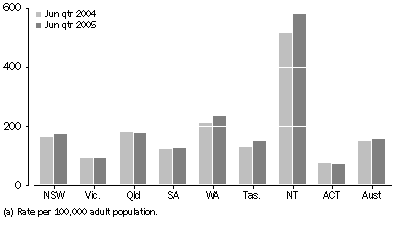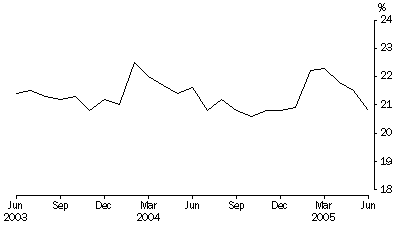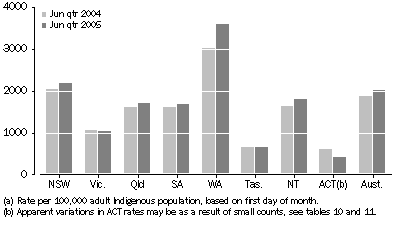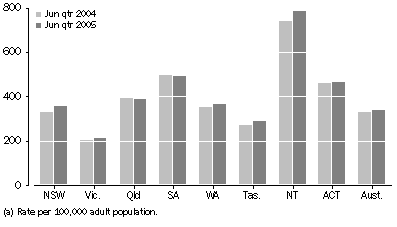ABOUT THIS PUBLICATION
This publication presents information on persons in custody and community-based corrections. The statistics are derived from information provided to the Australian Bureau of Statistics (ABS) from administrative records held by corrective services agencies in each state and territory, and from the Australian Government Attorney-General's Department for details on federal prisoners. Details are provided for each state and territory on: numbers and imprisonment rates by type of custody (i.e. open or secure custody or periodic detention); prisoner numbers by legal status (sentenced or unsentenced) for all prisoners and for Indigenous prisoners; the number of sentenced receptions into custody; the number of federal prisoners; and the numbers and rates of persons serving community-based corrections orders.
The ABS acknowledges the valuable contribution of the Board of Management and the Advisory Group of the National Corrective Services Statistics Unit as well as the staff of the various agencies that provide the statistics that are presented in this publication.
CHANGES IN THIS ISSUE
The presentation of tables 14, 15 and 16 has changed. Table 14 now presents both counts and rates of periodic detention. This data was previously presented as tables 14 and 15. Table 15 presents data for males and females. This data was previously presented as table 16.
FURTHER INFORMATION
More information about ABS activities in the field of crime and justice statistics is available from the Crime and Justice theme page on the ABS web site. Details of other ABS publications relating to Crime and Justice statistics can be found in paragraphs 36-37 of the Explanatory Notes.
INQUIRIES
For further information about these and related statistics, contact the National Information and Referral Service on 1300 135 070 or Marika Woodberry on Melbourne (03) 9615 7601.
SUMMARY OF FINDINGS
PERSONS IN CORRECTIVE SERVICES
Based on first day of the month data, for the June quarter 2005 there were 77,446 persons under the authority of corrective services comprising 24,392 persons in full-time custody and 53,054 persons in community-based corrections. This was an increase of 5% (3,697 persons) since the June quarter 2004. The largest proportional increases were in the Northern Territory (10%), followed by Western Australia and Tasmania (each 9%). The smallest proportional increases were in Queensland and South Australia (each 1%).
NUMBER OF PRISONERS
PERSONS IN PRISON CUSTODY, Average daily number per month

The average daily number of full-time prisoners in Australia in the June quarter 2005 was 24,382, an increase of 230 (1%) on the March quarter 2005 and 1,233 (5%) on the June quarter 2004. These increases reflect the upward trend of the annual average daily prisoner numbers.
RATES PER 100,000 ADULTS
AVERAGE DAILY IMPRISONMENT RATE (a)

Nationally, the average daily imprisonment rate was 157 prisoners per 100,000 adult population during the June quarter 2005, an increase of 4% since the June quarter 2004 (151 prisoners). The Northern Territory had the highest imprisonment rate (580 prisoners per 100,000 adult population), followed by Western Australia (234) and Queensland (178). The Australian Capital Territory (including Australian Capital Territory prisoners held in New South Wales prisons) and Victoria had the lowest imprisonment rates (73 and 92 prisoners per 100,000 adults respectively).
Of all states and territories, the largest proportional increase (15%) in imprisonment rates since the June quarter 2004 was recorded in Tasmania. The next highest increase was Northern Territory (13%), followed by Western Australia (11%). The largest proportional decrease (3%) over the same period was recorded in the Australian Capital Territory.
SEX
Of the average daily number of full-time prisoners in Australia in the June quarter 2005, 22,729 (93%) were male and 1,652 (7%) were female. The average daily imprisonment rate for males was 297 prisoners per 100,000 adult male population, while for females it was 21 prisoners per 100,000 adult female population. Males were 14 times more likely to be in prison than females.
TYPE OF FULL-TIME CUSTODY
The average daily number of prisoners in secure prison custody in the June quarter 2005 was 17,597 (72% of prisoners in full-time custody). The remaining prisoners were held in open prison custody. Nationally, the proportions of prisoners held in secure and open prison custody have remained stable over the past three years.
In the June quarter 2005, all prisoners held in full-time custody in the Australian Capital Territory were in secure custody. In other states and territories, the highest proportions of prisoners held in secure full-time prison custody were recorded in Victoria (92%) and South Australia (88%). The proportion of prisoners in secure full-time custody was lowest in New South Wales (including Australian Capital Territory prisoners held in New South Wales prisons) at 53%.
LEGAL STATUS
The average of the number of prisoners in full-time custody on the first day of each month in the June quarter 2005 was 24,392. Of these, the average number of unsentenced prisoners was 5,216 (21%). The Australian Capital Territory (including Australian Capital Territory prisoners held in New South Wales prisons) and South Australia had the highest proportions of unsentenced prisoners (38% and 32% respectively). The lowest proportion of unsentenced prisoners was recorded in Western Australia (16%).
PERSONS IN PRISON CUSTODY, Proportion unsentenced per month

SENTENCED RECEPTIONS
There were 6,351 sentenced receptions into full-time custody in Australia in the June quarter 2005. The number of sentenced receptions increased by 344 (6%) since the March quarter 2005, and by 117 (2%) since the June quarter 2004.
INDIGENOUS PRISONERS
INDIGENOUS PERSONS IMPRISONMENT RATE (a)

In the June quarter 2005 there were 5,686 Indigenous adult prisoners in Australia, comprising 5,206 (92%) males and 480 (8%) females. Almost 80% of the total Indigenous prisoner population was located in three states: New South Wales (1,739 persons); Western Australia (1,448); and Queensland (1,329).
The national rate of imprisonment for Indigenous people in the June quarter 2005 was 2,033 per 100,000 adult Indigenous population, an increase of 9% since the June quarter 2004 and an increase of 1% since the March quarter 2005.
The highest rate of imprisonment for Indigenous prisoners was recorded in Western Australia (3,602 Indigenous prisoners per 100,000 adult Indigenous population), followed by New South Wales (2,185).
INDIGENOUS IMPRISONMENT RATE (a)

Of all states and territories, the largest proportional increase (19%) in the rate of imprisonment of Indigenous people since the June quarter 2004 was recorded in Western Australia. The next highest increase was in Northern Territory (11%), followed by New South Wales (7%).
The age standardised national rate of imprisonment of Indigenous people from the National Prisoner Census at June 2004 was 11 times higher (1,417) than the rate for non-Indigenous people (129). Imprisonment rates in the National Prisoner Census take into account the different age profiles of the Indigenous and non-Indigenous populations. Further information on the comparison of imprisonment rates between Indigenous and non-Indigenous populations can be found in Prisoners in Australia 2004 (cat. no. 4517.0).
PERIODIC DETENTION
Periodic detention is a form of custody only used in New South Wales and the Australian Capital Territory. During the June quarter 2005 there was an average daily number of 846 persons in New South Wales and 106 persons in the Australian Capital Territory held in periodic detention. The rate of imprisonment for periodic detention increased in the Australian Capital Territory by 20% and in New South Wales by 14% between the June quarters 2004 and 2005.
FEDERAL PRISONERS
In the June quarter 2005, there were 658 federal prisoners in Australia, a decrease of 21 (3%) since the June quarter 2004. More than half (55%) of these federal prisoners were sentenced in New South Wales.
PERSONS IN COMMUNITY-BASED CORRECTIONS
Community-based correction orders are non-custodial orders under the authority of corrective services and include: restricted movement, fine option, community service, parole, bail and sentenced probation. In the June quarter 2005, there were 53,054 persons in community-based corrections in Australia, an increase of 2% (827 persons) since the March quarter 2005 and 5% (2,448 persons) since the June quarter 2004.
Rates per 100,000 adults
Nationally, the rate of persons in community-based corrections was 341 persons per 100,000 adult population for the June quarter 2005. This was an increase of 3% since the June quarter 2004 (330 persons per 100,000 adults). The largest increases since the June quarter 2004 were in New South Wales (7%), followed by the Northern Territory and Tasmania (each 6%). Queensland and South Australia recorded a decrease in rates (1%) over the same period.
COMMUNITY-BASED CORRECTIONS RATE (a)

In the June quarter 2005, community-based corrections for males was 566 per 100,000 adult male population compared to 121 females per 100,000 adult female population. Males were almost five times more likely to be in community-based corrections than females.
Type of orders
In the June quarter 2005, there were 31,149 persons serving a sentenced probation order (59% of all persons serving a community-based corrections order). This was an increase of 2% (504 persons) since the March quarter 2005 and 5% (1,526 persons) since the June quarter 2004.
In the June quarter 2005, there were 9,255 persons serving parole orders following a period of imprisonment. More than three quarters (76%) of the total persons serving parole orders were located in three states: New South Wales (4,134 persons); Victoria (1,578); and Western Australia (1,321).
 Print Page
Print Page
 Print All
Print All